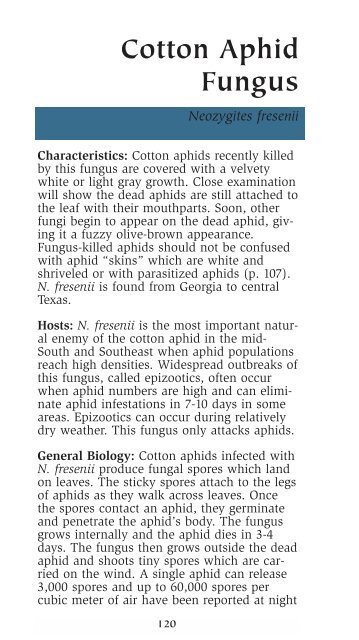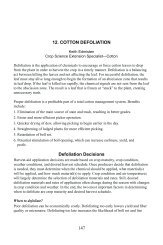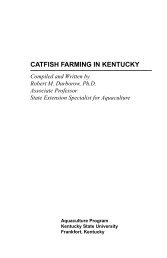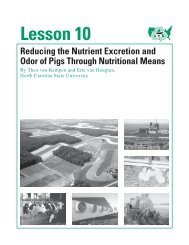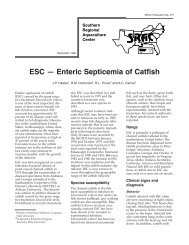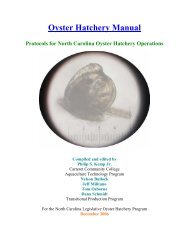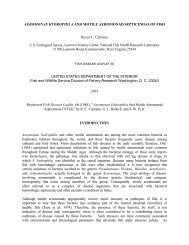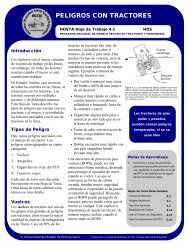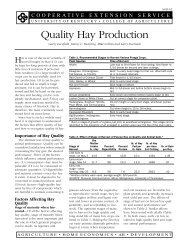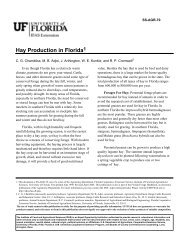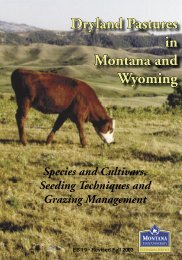Recognizing the Good Bugs in Cotton - Texas Is Cotton Country ...
Recognizing the Good Bugs in Cotton - Texas Is Cotton Country ...
Recognizing the Good Bugs in Cotton - Texas Is Cotton Country ...
Create successful ePaper yourself
Turn your PDF publications into a flip-book with our unique Google optimized e-Paper software.
<strong>Cotton</strong> Aphid<br />
Fungus<br />
Neozygites fresenii<br />
Characteristics: <strong>Cotton</strong> aphids recently killed<br />
by this fungus are covered with a velvety<br />
white or light gray growth. Close exam<strong>in</strong>ation<br />
will show <strong>the</strong> dead aphids are still attached to<br />
<strong>the</strong> leaf with <strong>the</strong>ir mouthparts. Soon, o<strong>the</strong>r<br />
fungi beg<strong>in</strong> to appear on <strong>the</strong> dead aphid, giv<strong>in</strong>g<br />
it a fuzzy olive-brown appearance.<br />
Fungus-killed aphids should not be confused<br />
with aphid “sk<strong>in</strong>s” which are white and<br />
shriveled or with parasitized aphids (p. 107).<br />
N. fresenii is found from Georgia to central<br />
<strong>Texas</strong>.<br />
Hosts: N. fresenii is <strong>the</strong> most important natural<br />
enemy of <strong>the</strong> cotton aphid <strong>in</strong> <strong>the</strong> mid-<br />
South and Sou<strong>the</strong>ast when aphid populations<br />
reach high densities. Widespread outbreaks of<br />
this fungus, called epizootics, often occur<br />
when aphid numbers are high and can elim<strong>in</strong>ate<br />
aphid <strong>in</strong>festations <strong>in</strong> 7-10 days <strong>in</strong> some<br />
areas. Epizootics can occur dur<strong>in</strong>g relatively<br />
dry wea<strong>the</strong>r. This fungus only attacks aphids.<br />
General Biology: <strong>Cotton</strong> aphids <strong>in</strong>fected with<br />
N. fresenii produce fungal spores which land<br />
on leaves. The sticky spores attach to <strong>the</strong> legs<br />
of aphids as <strong>the</strong>y walk across leaves. Once<br />
<strong>the</strong> spores contact an aphid, <strong>the</strong>y germ<strong>in</strong>ate<br />
and penetrate <strong>the</strong> aphid’s body. The fungus<br />
grows <strong>in</strong>ternally and <strong>the</strong> aphid dies <strong>in</strong> 3-4<br />
days. The fungus <strong>the</strong>n grows outside <strong>the</strong> dead<br />
aphid and shoots t<strong>in</strong>y spores which are carried<br />
on <strong>the</strong> w<strong>in</strong>d. A s<strong>in</strong>gle aphid can release<br />
3,000 spores and up to 60,000 spores per<br />
cubic meter of air have been reported at night<br />
120


